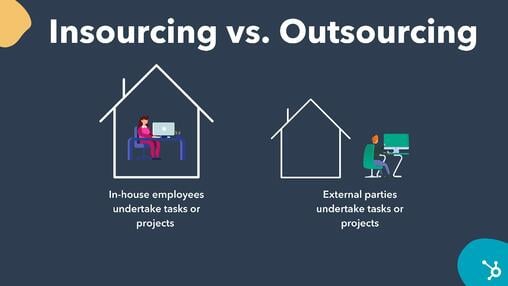Your employees know your business processes well. They understand your brand messaging and vision and feel a general sense of connectedness to your organization.
Given this, many businesses choose to insource and have existing employees undertake new tasks rather than hiring freelancers or other agencies that don’t have an existing connection to your business.
In this post, discover exactly what insourcing is, the benefits it can bring to your business, and examples of scenarios that would cause you to use the strategy.
Insourcing brings a variety of benefits to companies, like:
- Having more control over the decisions that go into tasks and projects because everything is kept in-house.
- Existing employees are experienced with brand messaging and the brand experience, so you don’t have to spend extra resources getting others up to speed.
- Communication isn’t tricky as you don’t need to reach out to third parties.
- You don’t need to share critical business information with external sources.
However, insourcing can also become costly if it requires hiring new talent or creating new departments to be responsible for specific tasks and projects. Employees can also become burnt out if they are assigned a heavier workload to accomplish projects, so some businesses elect to use outsourcing.
Insourcing vs. Outsourcing
Insourcing and outsourcing are opposites.
With outsourcing, a company hires an external third party, like a public relations firm, to complete a task, project, or take over a continuous function for the company. With insourcing, all tasks, projects, or continuous processes are done by internal employees, even if it means hiring new talent or creating new departments.

A common use case for outsourcing is payroll needs. For example, if a business is smaller and doesn’t have the resources to create a payroll department, or nobody on staff is trained in payroll needs, they may outsource the task to an experienced payroll firm.
Businesses may choose to use outsourcing over insourcing for a variety of reasons, like:
- Eliminating the costs associated with hiring new employees,
- Reducing workload for internal teams to avoid burnout,
- Allowing employees to focus on core business functions while external parties cover less critical operations,
- New needs that arise due to scaling.
A business may choose to use insourcing over outsourcing as the ladder often requires handing over internal systems and processes to a third party, which can pose a significant risk when dealing with sensitive information, and communication can sometimes be challenging to navigate.
Insourcing Examples
Let’s go over some examples of insourcing that may provide additional insight into the practice.
- A business is scaling to different territories, but its current marketing teams aren’t familiar with the language in the new area. So, it hires a new team in the territory that is familiar with the language and will be responsible for creating marketing strategies that speak to the needs of the new audience.
- An organization wants to expand its line of products, so it works with internal product teams to brainstorm new ideas and bring them to fruition instead of outsourcing the work to an external unit. This ensures that teams working on new products have expertise on current business practices, and confidential systems don’t need to be shared with outside sources.
- After scaling, a business CEO can no longer be responsible for payroll as it is a more significant task than before. So, instead of hiring an external payroll firm, the business hires new talent experienced in payroll duties and creates an in-house payroll department.
Over To You
If you want your business to undertake new projects or scaling has required you to need new processes, consider using insourcing if your overall goal is to have everything done in-house.
Your internal teams, or newly hired talent, will take ownership of new tasks, bring them to fruition, and contribute to your business success.




Recent Comments